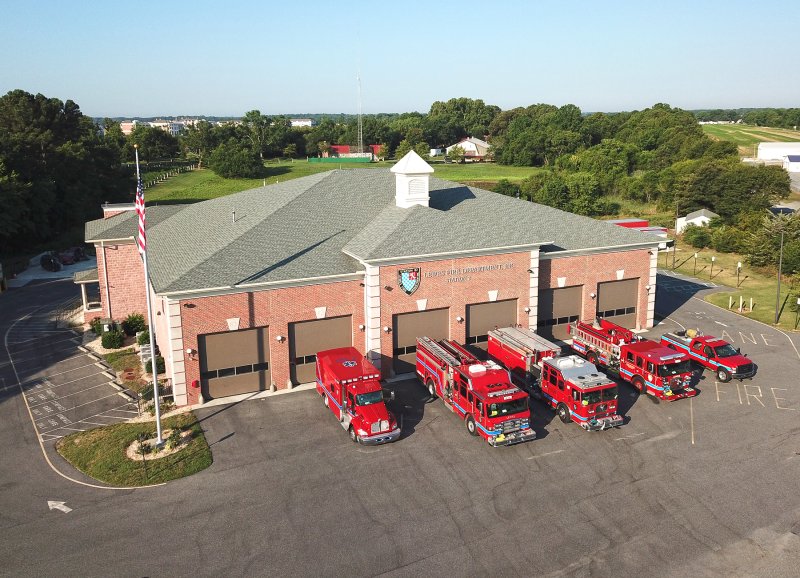Fire service fee recommended in Sussex County
A study of Sussex County fire departments’ finances released June 3 recommends more funding through the county budget or creation of a new fee to help departments struggling to provide service, especially ambulance coverage.
Over the past year, FACETS Consulting reviewed the 24 departments that serve 275,000 county residents. The consultant gathered financial information from each fire department, toured its facilities and spoke with its leaders. The 542-page report was posted June 3 on the county government website.
A declining number of volunteers, increasing calls for service in the fast-growing county and rising costs are straining fire departments’ personnel and finances, said Kevin Roche, principal of FACETS, who presented the findings with associate Natasha Nau.
“Sussex County is not doing terribly,” Nau said. “They have a good average score. This was not the case in New Castle County.”
The report encourages the county and fire departments to do strategic planning and that consideration be given to dealing the possible elimination of ambulance service by some departments. It also recommended fire departments work together to consolidate equipment purchases and that individual departments seek grants, hire professional financial services and take other steps to improve finances and operations. The county could also provide guidance in purchasing and billing procedures to save money, the report stated.
“They did a very good job to quantify the health of all the fire departments and ambulance services in the county,” said Council President Douglas Hudson after the meeting. “It will help us to go forward with our work.”
Hudson said the report comes too late to allow changes in the annual county budget, scheduled for a Tuesday, June 17, public hearing and approval by the end of the month.
He said council will meet with fire department representatives as it considers whether to provide additional funding through a budget amendment or creation of a fire service fee.
One of the main points of the long-awaited study is that the fire and basic life support ambulance model in Sussex County is becoming less sustainable.
“A system that worked very well for decades is being challenged by a number of factors, including population growth, higher demands for emergency services, urban development, increased costs, societal shifts in volunteerism and financial pressure on families,” the report states.
Fire departments in Delaware receive nearly all of their funding through county and state budgets, while those in many other states are funded largely through a separate fire tax.
“The fact that fire departments are so dependent on the county and so dependent on the state is unique, I think, to Delaware,” Roche said. “Everything helps, but I do think it’s going to take the fee to really bring companies up to the level they need to be to continue where they’re going, to pay competitive salaries.”
Lewes Fire Department Treasurer Bryan Pepper attended the June 3 council meeting.
“It’s not a surprise,” Pepper said of the report findings after the FACETS presentation. “The call volume keeps increasing [but] the county’s contribution doesn’t increase.”
He said volunteer fire departments provide a critical service to their communities, one that would be much more expensive if paid staff were needed to replace volunteer firefighters.
Paid ambulance staff supplement the firefighting crews, when available, at Sussex County fire departments.
“The volunteer fire departments are the best investment in the county budget,” Pepper said. “It is a steal.”
Ambulance service is a losing financial proposition for fire departments, which need more funds to cover their costs, Pepper said. The department warned county council earlier this year that Lewes ambulance service is at risk of being abandoned if the county does not allocate more to cover costs.
Pepper said the fire and ambulance calls are averaging 21 per day total, more than the average for all of 2024, and that is before the start of the beach tourism season. The Lewes Fire Department has six ambulances.
Council Vice President John Rieley said he had extensively reviewed the study since receiving it and had noticed trends, including more financial stability in larger fire departments closer to the coast, where much of the development has occurred in recent years.
Councilman Steve McCarron, a longtime Bridgeville firefighter, said he prefers the county provide assistance, rather than the state.
“I think the fire services have done an outstanding job getting to this point, and will continue doing an outstanding job,” McCarron said.
Kevin Conlon came to the Cape Gazette with nearly 40 years of newspaper experience since graduating from St. Bonaventure University in New York with a bachelor's degree in mass communication. He reports on Sussex County government and other assignments as needed.
His career spans working as a reporter and editor at daily newspapers in upstate New York, including The Daily Gazette in Schenectady. He comes to the Cape Gazette from the Cortland Standard, where he was an editor for more than 25 years, and in recent years also contributed as a columnist and opinion page writer. He and his staff won regional and state writing awards.
Conlon was relocating to Lewes when he came across an advertisement for a reporter job at the Cape Gazette, and the decision to pursue it paid off. His new position gives him an opportunity to stay in a career that he loves, covering local news for an independently owned newspaper.
Conlon is the father of seven children and grandfather to two young boys. In his spare time, he trains for and competes in triathlons and other races. Now settling into the Cape Region, he is searching out hilly trails and roads with wide shoulders. He is a fan of St. Bonaventure sports, especially rugby and basketball, as well as following the Mets, Steelers and Celtics.
























































